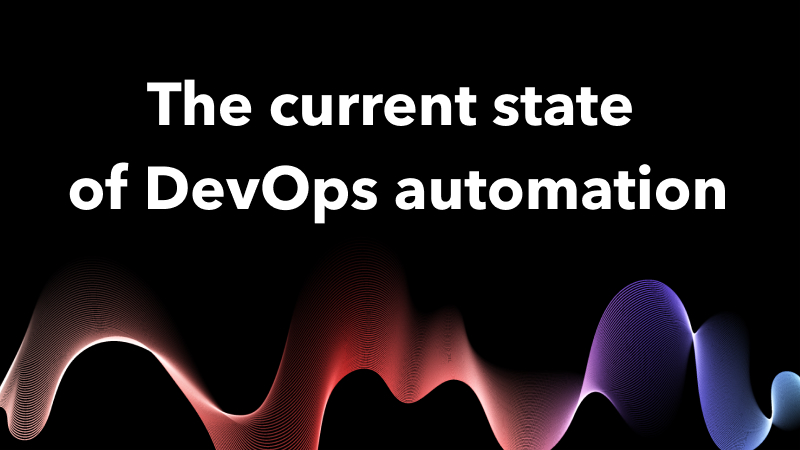Digital transformation has significantly increased the organizational demand to innovate faster. But with many organizations relying on traditional, manual processes to ensure service reliability and code quality, software delivery speed suffers. As a result, organizations are investing in DevOps automation to meet the need for faster, more reliable innovation.
Automation is a crucial aspect of achieving DevOps excellence. But according to the 2023 DevOps Automation Pulse, only 56% of end-to-end DevOps processes are automated. The increasing complexity of cloud-native technologies has placed unprecedented pressure on DevOps teams. Organizations with underdeveloped automation can face detrimental consequences. In addition to rising IT costs and a turbulent economy, DevOps automation has shifted from an efficiency drive to a strategic imperative for organizations looking to keep up with the pace of today’s technological landscape.
The first step to improving automation requires a greater understanding of it. The 2023 DevOps Automation Pulse offers a comprehensive overview of the modern circumstances of DevOps automation. The report surveyed 450 IT practitioners across organizations of diverse sizes, sectors, and countries. This blog will break down how the report addresses the current state of DevOps automation, the impact of automation investments, prevalent barriers to automation adoption, and the future of DevOps automation.
The current state of DevOps automation

While many organizations are investing in DevOps automation, there is still a long way to go before the practice becomes commonplace. Without autonomous operations, DevOps teams face an increased volume of manual interventions, which are detrimental to productivity, cost efficiency, and employee satisfaction.
According to the survey, there are an average of nine manual interventions (including approvals and security) in an end-to-end DevOps pipeline. Moreover, it takes an average of nine hours for a software engineer to remediate a problem within a production application. DevOps automation is necessary to increase speed and efficiency in the software development pipeline.
The report also outlines the most common tools used for automation and offers insights into how to consolidate them and break down silos between teams. The most popular tools include Kubernetes (67%), Azure DevOps (66%), and GitHub (53%). Furthermore, organizations are now recognizing how observability has become a prerequisite for DevOps automation. The report outlines the numerous benefits of integrating observability into automation optimization, including faster incident response, automated release validation, and bottleneck identification.
The impact of automation investments
DevOps automation has provided a tremendously wide variety of quantifiable benefits to the organizations that embrace it. These benefits include improved software quality (61%), cost reduction (55%), and faster time to market (49%). Organizations are also recognizing the wider benefits of DevOps automation, such as greater employee satisfaction.
Beyond quantifying achievable benefits, the report describes common key performance indicators and service-level objectives that organizations use to evaluate the success of automation. These metrics can serve as a framework for other organizations looking to create their own automation models.
Barriers to automation adoption
Although DevOps automation provides a plethora of measurable benefits, several barriers to automation still exist and prevent organizations from fully realizing these benefits.
Identifying and quantifying these barriers is crucial to ultimately overcoming them. The report outlines a diverse set of common barriers that organizations face, such as toolchain complexity (53%) and siloed teams (46%). Moreover, many teams lack access to the key skills that drive autonomous operations. Read the report to learn more about the specific, necessary skill sets that organizations typically lack.
The future of DevOps automation
With consistent developments emerging at a rapid pace, the future of DevOps automation is exciting and ever-evolving. The report touches upon several of the prospects associated with the expanding practice of DevOps automation. It also shares key practices that will greatly assist teams in driving their own automation. Chief among these practices are platform engineering and GitOps, which are becoming increasingly central to maturing DevOps automation practices with more than half (54%) of organizations investing in this area. Additionally, rapid developments in AI capabilities will continue to have a significant impact on automation optimization. These AI developments will enable teams to execute DevOps processes faster than ever before. In fact, 59% of organizations expect large language models (LLMs) such as ChatGPT and Bard to have a significant impact on their DevOps automation capabilities. For this reason, AI must mature alongside automation.
Take the DevOps Automation Assessment
Included within the report is a maturity model that outlines four progressive stages of DevOps automation maturity: foundational, standardized, advanced, and intelligent. The report describes the various benchmarks that constitute each stage in depth. The report also includes a DevOps Automation Assessment to determine where you stand within this maturity model. The assessment determines your maturity stage in four key categories of DevOps automation:
- Automation Governance
- Development & Delivery
- Operations
- Security
No matter which stage you fall into, the report provides a table containing specific, actionable recommendations for each stage that will help you advance your automation practices.
Download the free report to learn more about how you can improve your automation practices today. Consider also taking the DevOps Automation Assessment to better understand your own organization’s automation maturity.





Looking for answers?
Start a new discussion or ask for help in our Q&A forum.
Go to forum